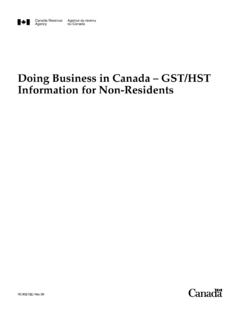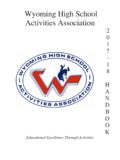Transcription of The Role of the Nursing Regulator in Safe Controlled Drugs ...
1 The Role of the Nursing Regulator in Safe Controlled Drugs and Substances prescribing and harm reduction Guidance for Regulators of Registered Nurses and Nurse Practitioners April 2017 2 ContentsContentsContentsContents CCRNR Guidance Working Group .. 3 Introduction .. 4 Document Structure and Guidance Development .. 4 Evidence Framework .. 5 Recommendations and Evidence .. 6 References .. 17 3 CCRNR Guidance Working GroupCCRNR Guidance Working GroupCCRNR Guidance Working GroupCCRNR Guidance Working Group This document was developed on behalf of CCRNR by a working group comprised of staff members from Canada s provincial and territorial Nursing regulatory bodies. Association of Registered Nurses of Newfoundland and Labrador Michelle Carpenter Association of Registered Nurses of Prince Edward Island Audrey Fraser Nurses Association of New Brunswick Susanne Priest College of Registered Nurses of Nova Scotia Lynn Miller College of Nurses of Ontario Erin Tilley College of Registered Nurses of Manitoba Diana Heywood, Deborah Elias Saskatchewan Registered Nurses Association Donna Cooke College and Association of Registered Nurses of Alberta Carolyn Trumper, Robin Cooper College of Nurses of British Columbia Chris Daly, Christine Penney.
2 Alison Wainwright Yukon Registered Nurses Association Andrea Oldridge Registered Nurses Association of Northwest Territories and Nunavut Denise Bowen 4 IntroductionIntroductionIntroductionIntr oduction Nursing is the largest regulated health profession in Canada with registered nurses and nurse practitioners representing the majority of this workforce (Canadian Institute for Health Information, 2013; 2015). As such, nurses are consistently at the front lines in dealing with the spectrum of impact associated with opioid use across the lifespan including its effects on children and families, management of co-morbidities, and supporting community harm reduction and client recovery efforts. Health professions regulators charged with protecting the public hold significant responsibility in developing, adapting and setting policy priorities that are responsive to changing health system needs and rapidly evolving practice.
3 Acting as leaders in benchmarking policy direction on Nursing scope of practice, professional accountability and standards of practice, regulators of registered nurses and nurse practitioners must balance the use of the best available evidence with the socio-political landscape and legal obligations. The Regulator is one stakeholder in a complex environment where multiple stakeholders are collaborating on solutions to the opioid crisis. The current epidemic of opioid use in Canada highlights the position of the regulatory role at the intersection of the individual nurse, health systems and government, illustrating the requirement of a nationally consistent understanding of how these pieces fit together in the interest of public protection. It is through this public protection lens that Nursing regulatory bodies across Canada have been involved in ongoing policy research and deliberation to address safe prescribing and harm reduction practices, including participation in national, provincial and territorial initiatives.
4 Under the direction of CCRNR, collaborative working groups have developed consistent policy approaches to the touchstones informing safe prescribing and harm reduction practices, including nurse practitioner Controlled Drugs and substances (CDS) prescriber education and registered nurse and nurse practitioner entry-level competencies. This document builds on knowledge developed through previous national work, presenting evidence-informed guidance for regulators of registered nurses and nurse practitioners. Its intention is to support the implementation of a consistent and standardized approach to addressing the regulatory policy elements associated with opioid use and harm reduction , including: 1. Controlled Drugs and substance prescribing for nurse practitioners; 2. Entry-level and remedial education on prescribing competencies for nurse practitioners; 3.
5 Education and practice with respect to harm reduction ; 4. Utilization of electronic pharmacy management e-systems supporting medication reconciliation; 5. Monitoring of prescribing and quality assurance; and 6. Entry-level competencies for registered nurses including ways to support effective pain management and limit abuse potential. Document Structure and Guidance DevelopmentDocument Structure and Guidance DevelopmentDocument Structure and Guidance DevelopmentDocument Structure and Guidance Development Guidance is structured in the form of recommendations, organized by category and key element with accompanying evidence and rationale. Categories include the six descriptors presented above. Key element refers to the specific aspect of focus for the presented recommendations within each category.
6 5 The development and evolution of recommendations occurred through an iterative process undertaken by the CCRNR guidance working group, including application of the evidence framework described below and consensus building to structure and revise proposed recommendations. Evidence FrameworkEvidence FrameworkEvidence FrameworkEvidence Framework The evidence framework informing the presented recommendations is adapted from the Centre for Disease Control s (CDC) Framework for Thinking about Evidence (CDC, 2013a; b). It considers evidence in three contexts deemed important to informing the elements of Nursing regulatory policy and practice. Best Available Research Evidence: refers to evidence derived through a process of systematic and/or scientific inquiry informing on the outcomes of an intervention, practice, program or policy.
7 Considered in the context of quantity, quality and design it provides support for proposed decisions and recommendations. Contextual Evidence: evidence based on factors addressing whether a proposed strategy or intervention is useful, feasible to implement and accepted by a particular community. Examples of data collection sources include focus groups, surveys and interviews. Experiential Evidence: evidence based on the real-world experience and expertise of professionals and subject matter experts, considering insight and understanding accumulated over time. Contextual EvidenceExperientialEvidenceBestAvailabl eResearch Evidence 6 Recommendations and EvidenceRecommendations and EvidenceRecommendations and EvidenceRecommendations and Evidence Controlled Drugs and Substances prescribing for Nurse Practitioners Key Element Recommendations Evidence or Rationale Standards and guidance Nursing regulators should consider: Providing direction to nurse practitioners on CDS prescribing in the form of regulatory standards and/or guidance.
8 Including in that guidance, information encompassing: reference to best practice educational requirements medication reconciliation and review utilization of available electronic pharmacy management e-systems prior to prescribing , where available Regulatory standards/guidance identify the minimum expectations for practice set by the Regulator . They hold regulatory force over other policy documents and as such illustrate the depth of responsibility and accountability required to participate in an aspect of practice. Requirements articulated in standards and guidance reflect the application of a systematic policy process considering best available research evidence, socio-political concerns and comprehensive expert and stakeholder consultation. Competencies Nursing regulators should consider: Continuing to make evidence informed decisions related to the development of entry-level competencies for CDS prescribing .
9 That entry-level competencies serve as a foundation for: assessment, measurement and evaluation in nurse practitioner practice education programs and exam development; and quality assurance and continuing competence outcomes Under CCRNR (2015), following a national NP practice analysis, new entry-to-practice competencies related to CDS were identified. These include: determining the client s potential risk profile or actual risk behaviors ( , alcohol, illicit Drugs and/or Controlled substances, suicide or self- harm , abuse or neglect, falls, infections); and applying strategies to reduce risk of harm involving Controlled substances, including medication abuse, addiction, and diversion prescribing competencies are a foundational component in the development of evidence-based legislation and regulatory initiatives addressing advanced Nursing practice (Klein & Kaplan, 2010; Klein, 2011).
10 Controlled drug prescribing presents a significant level of risk requiring complex decision making. As such, competencies should build on those developed for 7 Controlled Drugs and Substances prescribing for Nurse Practitioners Key Element Recommendations Evidence or Rationale other aspects of prescribing (Wainwright et al. 2016). In medical education, experts are making strong recommendations that substance abuse, addictions and pain management competencies be integrated into graduate medical programs (Suzuki et al. 2014; Kunins et al. 2013; Lavingne, 2016). Training recommendations include providing: trainees with an appropriate network of experienced faculty a system supporting the development of desired clinical skills and behaviours multiple opportunities to practice skills and behaviours didactic and experiential curricula, in addition to personalized feedback Education Nursing regulators should consider: Setting expectations that nurse practitioners who have not attained Controlled drug prescribing competencies through entry-level education complete additional education.






